Watching the Watchers: Power and Politics in Second Life (Part One)
/In early 2007, I ran an interview on this blog with Peter Ludlow, who teaches in the Philosophy Department at Northwestern University, and who has emerged as a key observer of how people are interacting within virtual worlds, such as The Sims Online and Second Life. Ludlow, along with his coauthor, Mark Wallace, wrote a book for MIT Press, The Second Life Herald: The Virtual Tabloid Which Witnessed the Dawn of the Metaverse, which I am planning to teach as part of a course I am developing this fall for the USC Journalism school on civic media. Ludlow emailed me recently with news of some fascinating new developments in Second Life. It was a story which raised such fascinating issues about fantasy and play, about the shifting borders between pro-social and anti-social behavior, about rights and responsibilities, and about the governance of virtual worlds that I felt like I had to share it now. Over the next two installments, I will be sharing Ludlow's account of what's been happening in Second Life, an account which places it in the context of the larger history of virtual worlds. Afterwords, I will share a joint statement which emerged from our conversations together about what this all means.
Watching the Watchers
By Peter Ludlow
Dept. of Philosophy
Northwestern University
People who have spent time inside virtual worlds are familiar with griefers - game players (stereoptypically adolescent males) who engage in transgressive online gameplay to disrupt the online experience for others. The transgressive behavior might range from profanity, scatological behavior and racism to the writing of programs (scripts) that tax the servers of the virtual world to the point where it goes offline.
If you are familiar with griefers, then you are probably also familiar with user created virtual security operations that have emerged to counter griefers. For example, Ludlow and Wallace (2008) describe a case inside of (the now defunct) virtual world The Sims Online. Fed up with the behavior of a handful of griefers, a group of players formed a virtual paramilitary organization called "The Sim Shadow Government" (SSG). Organized into an executive branch, an intel branch, and a "war department", the SSG monitored the movement of griefers inside of The Sims Online, followed them in the game, warned other users about them by using negative reputational tags, and often filed "abuse reports" with the game company (for example, reporting players for violations of the terms of service of the game company).
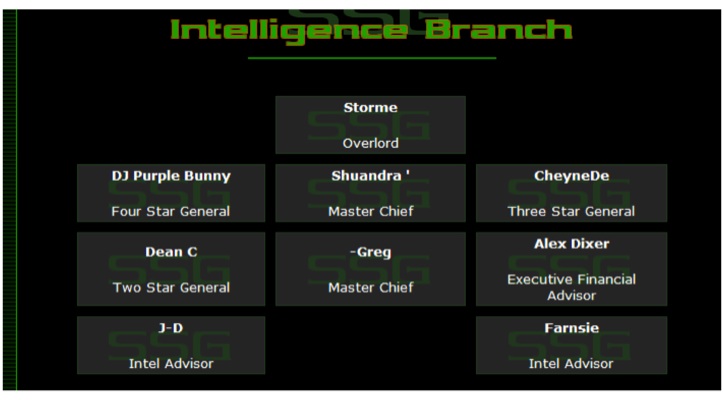
SSG Intelligence Branch, organizational chart.
Some players inside of The Sims Online felt that the SSG went too far in their operations. Members of the SSG were quite capable of hounding people out of the game without benefit of fair hearing or trial, and they were also very close to the game monitors of the game company, yielding charges of favoritism. Protest organizations with names like "Freedom Gameplay" and "The Lightsavers" (dedicated to casting out the shadows) emerged and pushed back with anti-SSG propaganda and with griefing attacks against the SSG itself.
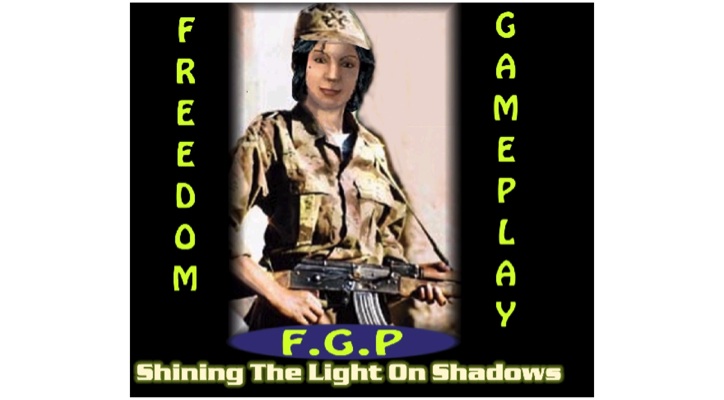
Freedom Gameplay organizes against the SSG
This might seem like an odd and fleeting phenomenon, but in fact it is replicated many times over in virtual worlds. Trouble makers enter the world, and antibodies form to fight the trouble makers, apparently as a completely emergent phenomenon. The only difference is that as virtual worlds become more important and visually rich the intensity of the battles has risen dramatically. A recent episode from Second Life illustrates just how dramatically.
Second Life, of course, is a virtual world in which the developers provide users with robust tools to build and "script" objects, ranging from clothing and homes to vehicles and weapons. The result is that there is much user created content - some of it very edifying, some of it junk, and some of it obscene. For example, a Second Life griefer group known as the W-Hats had a property featuring giant penises, swastikas, and a "build" with a Death Star blasting the World Trade Center.
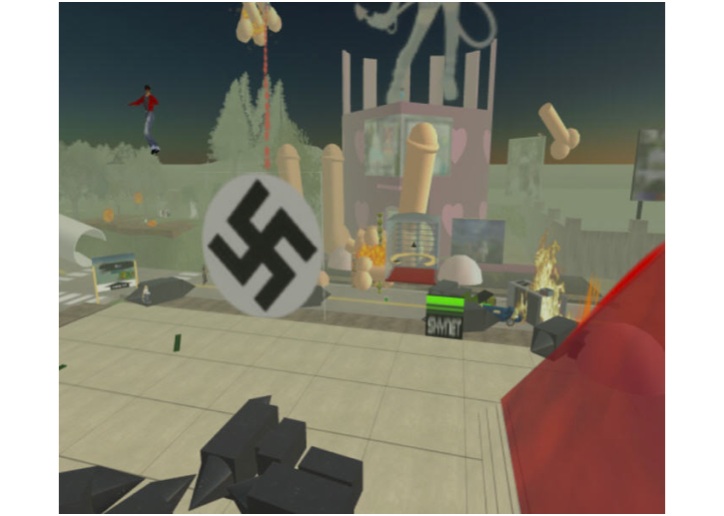
The W-Hat "build"
Another griefer group, called the Patriotic Nigras (PN) routinely engaged in racist and transgressive behavior, targeting clubs inside of Second Life and took credit for griefing the Second Life political campaign headquarters for John Edwards (The W-Hats also took credit. The Edwards campaign blamed Second Life Republicans).

John Edwards' virtual campaign headquarters griefed. PN take credit.
The PN in turn had been spawned by an infamous internet web site known as 4chan - an online site famous for its adolescent hijinxs that included spamming their enemies with famous scatological internet content like "Tub Girl" and "Goatsee". More specifically, the PN had been organized on /b/, a section of the 4chan site dedicated to transgressive behavior.
The PN actually came into existence in 2005, when members of 4chan ("channers") decided to raid Habbo Hotel, a virtual world aimed at younger children. The channers created black presenting avatars with afros, and surrounded Habbo's virtual swimming pool warning the children that "the pool is closed because of aids." Thus were born the PN, and their slogan (still used) "Pool's Closed". A griefer organization like that with a permanent presence inside of Second Life was bound to be the virus from which a virtual vigilante group emerged.
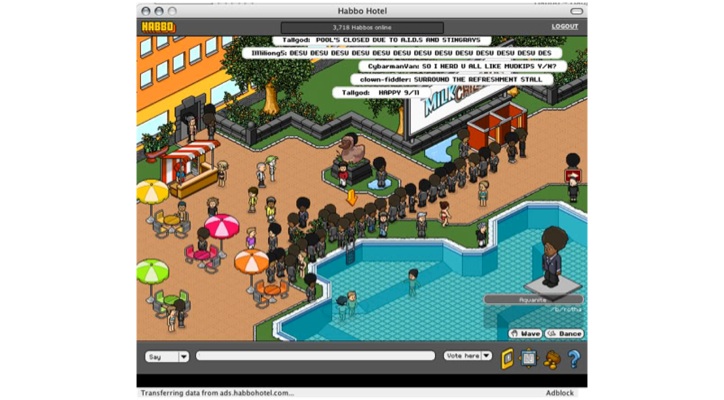
Pool is closed: 4chan invades Habbo Hotel, 2005
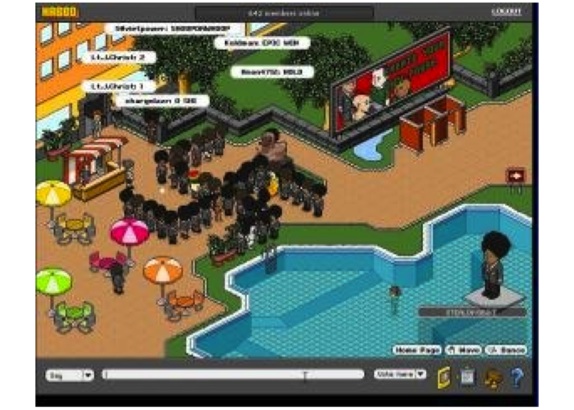
Channers get transgressive.
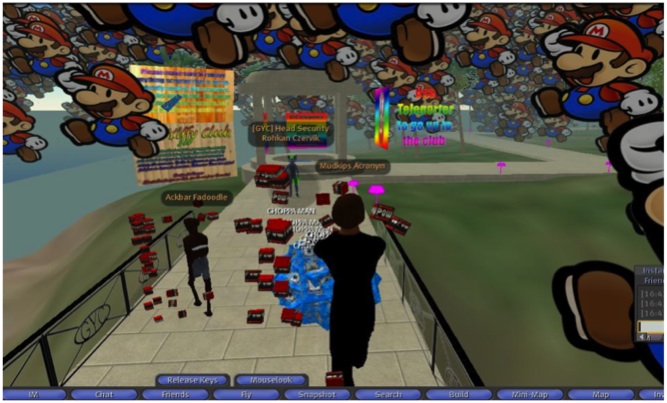
The PN comes to SL and attacks the Gay Yiffing Club (GYC) with self-replicating Marios
In 2006, a Second Life avatar by the name of Kalel Venkman decided to create a vigilante group to fight the likes of the PN, and he decided it would be fun to do it in the guise of comic book superheroes. He donned a Superman skin, and he named his group the "Justice League Unlimited." Other familiar superheroes soon followed, including The Green Lantern, Batman, Wonder Woman, and others.
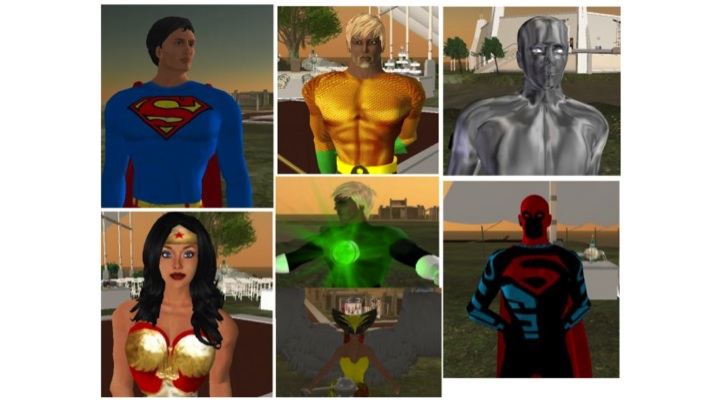
A New Sheriff in town: the JLU
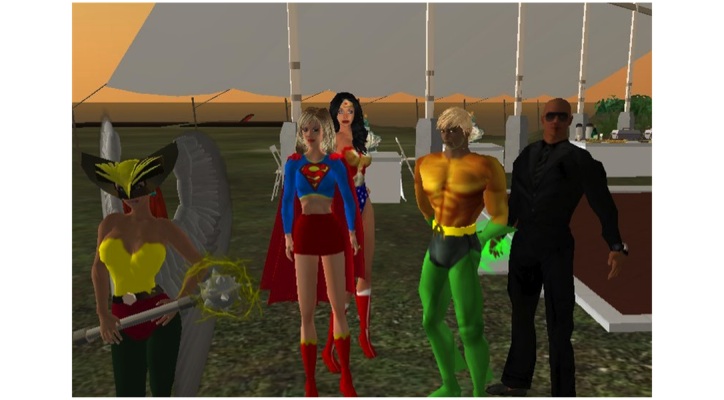
JLU Members in happier times.
In real life, Kaleel was a late middle aged technical writer living in Simi California. He apparently had flex time, and he also appeared to have sufficient charm and gravitas to attract members to the Justice League and to keep them well organized and on mission. Their Justice League headquarters had a marvelous NASA quality control room, with monitors that displayed constant updates coming in from sensors all over the Second Life grid. The updates also informed the League members what representatives from the game company were online. As with the SSG, the Justice League had close contacts with employees of the game company (Linden Lab), and utilized those relationships in filing abuse reports against other players.
What perhaps began as a fun exercise in roleplay soon began to go awry. Overzealous Justice League members began abuse reporting heavily, and also began picking fights with unlikely groups within Second Life. For example, the Justice League was banned from Furnation (an area inside Second Life dedicated to players that like to don anthropomorphized animal costumes), because of their excessive vigilantism.
The JLU of course clashed with the PN, but the problem became determining who was really a member of the PN and who was simply in the orbit of the PN. Matters took on fractal complexity when some students of Woodbury University (a real life University with a virtual campus inside Second Life) became associated with 4chan and the PN. In what seemed like a bizarre case of guilt by association, the members of the Justice League took on the students of Woodbury University, at one point successfully getting Linden Lab to shut down Woodbury Island (the virtual campus). Naturally matters quickly escalated.
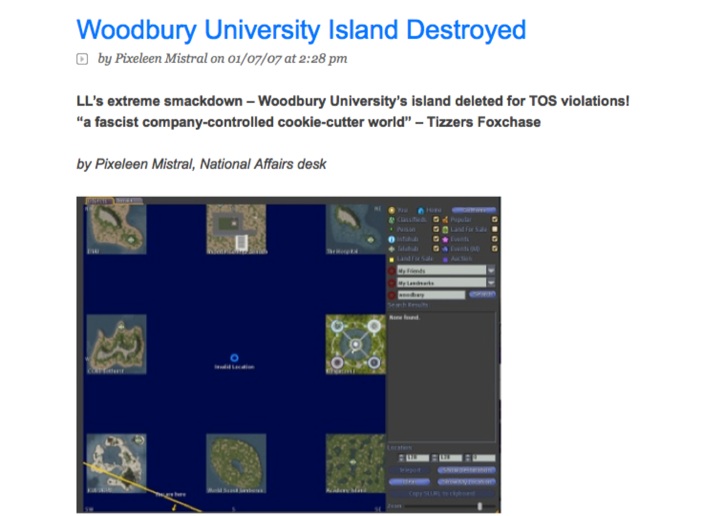
Someone (presumably from the Justice League) contacted the administration at Woodbury University to complain about the faculty supervisor of Woodbury and to argue (in effect) that he was corrupting innocent youth and inspiring them to griefer ways. In turn, the students, led by the avatar Tizzers Foxchase (Jordan Belino in real life) turned up the heat on Kalel, to the point where a number of Woodbury students went trick or treating at Kalel's house on Halloween. Kalel wasn't home, so the students told his wife to tell him that Woodbury had been there. Kalel naturally flipped out.
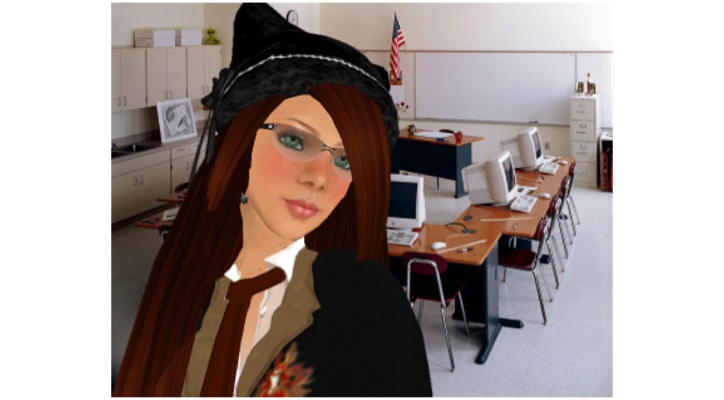
Tizzers Foxchase
Tizzers herself was not a member of the PN; she seemed to have not much more of an agenda than to fight the Justice League and defend Woodbury. For Kalel, however, the Woodbury claims of innocence were nothing more than Eddie Haskelling ("lovely hair Mrs. Cleaver"). Tizzers was a griefer in spite of her nice young lady rap, and that was that. The problem was that more and more people were starting to look like griefers to Kalel, including people who were his competition in the virtual world security business - or at least this was the claim of Intlibber Brautigan, a Second Life real estate mogul, famous for posting libertarian manifestos on the forums. If Intlibber was to be believed, the harassment from the Justice League had been financially motivated and astoundingly heavy handed.
"How about the meanness of the JLU in getting countless innocents permabanned from SL for the mere act of being a black avatar, or saying an internet meme in chat, or being falsely abuse reported with impossible charges (like "copybotting a megaprim owned by Michael Linden"), or participating in public protests.
Yes, these people deserve a lot more than "a little meanness". Lets get it straight, they are snitches, rats, stool pigeons, LIARS, defamers, collaborators, trespassers, and instigators. Siobahn McCallen, who resided in my sims with her girlfriends yet worked with JLU in defaming me and encouraging my residents to leave. These sort of people don't deserve niceness."
Intlibber also complained that the tactics of the JLU worked to get innocent gamers banned:
"Anybody who teleports into a monitored sim within 5 minutes before a sim crashes gets logged to their db as a suspect, and given a score. The number of times this happens jacks up your score. Your score is further handicapped by how young your avatar is and what your payment status is (helps to catch throwaway alts quickly)."
Any account that scores too highly on this system gets automatically abuse reported by a bot to Linden Lab, no further investigation done by human hands.
The JLU contended that IntLibber had hired the PN to grief his enemies in the virtual real estate business, but no evidence was brought forward.
It wasn't just their competitors that were marked as griefers; the Alphaville Herald, which had been reporting on griefers in virtual worlds since 2003, was a griefer media organ in Kalels eyes. The Herald's editor, an avatar Pixeleen Mistral was therefore also a griefer. Kalel came to falsely believe that Pixeleen was identical with me, and so I must be a griefer too. There were griefers everywhere, it seemed.
(More to Come. Same Bat Time, Same Bat Channel)


![Reblog this post [with Zemanta]](http://img.zemanta.com/reblog_e.png?x-id=6fd8f73b-d54f-4ef7-a896-4ffeb2a19c56)